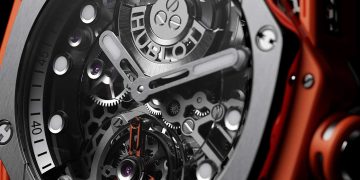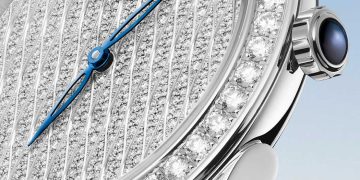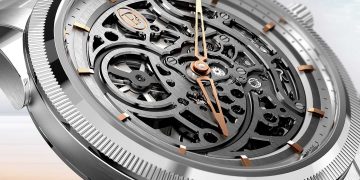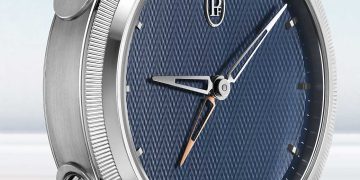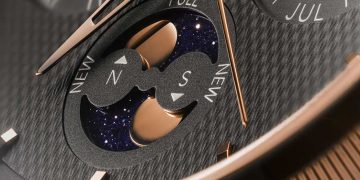SUMMARY
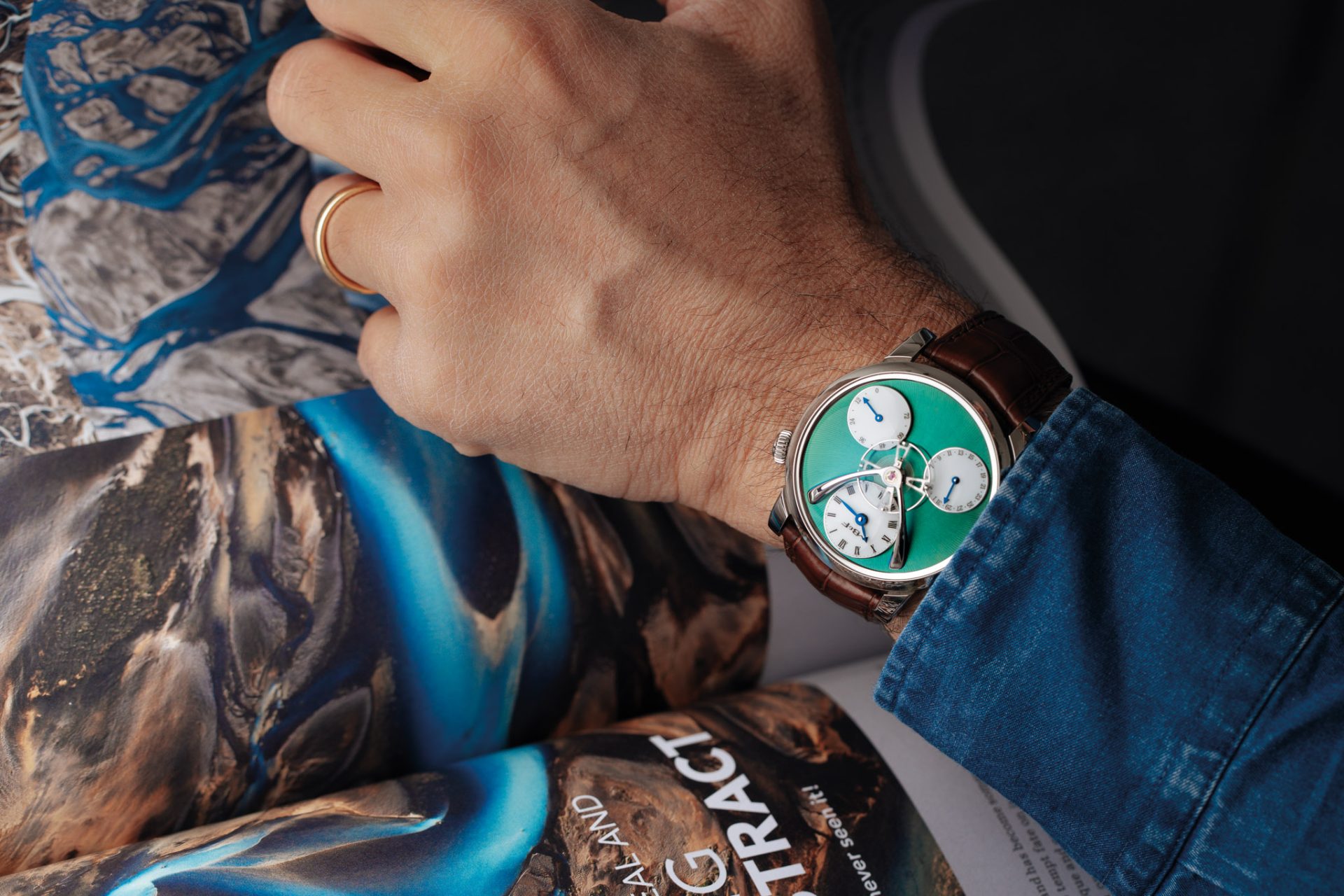
There is one technical constant that defines every single watch in the MB&F Legacy Machine collection. Functions may vary, and different complications come to the fore in each edition, but the suspended balance wheel remains literally and metaphorically above everything else. In Legacy Machine Split Escapement, this feature is not only highlighted, but raised to another level of achievement.
Just below the highest point of the domed dial crystal, the balance of LM SE beats at a sedate, traditional 2.5Hz / 18,000bph. What is rather less traditional is its construction. Unlike most of the other suspended balances in the Legacy Machine collection — indeed, unlike any other balance outside of MB&F — the balance of LM Split Escapement seems to oscillate on its own, without any visible intake of energy. The essential remaining parts of the escapement, which provide the driving impulse – anchor and escape wheel – are concealed on the opposite side of the movement, almost 12 mm below; hence the name ‘Split Escapement’.
Under the balance, the triple-dial design of LM SE gives the time at 12 o’clock, the power reserve indication at 4 o’clock and the date at 8 o’clock. The date can be quickly and easily adjusted thanks to a push-button on the side of the case, next to the date dial.
Other design features are natural evolutions of those found in previous Legacy Machines, such as the organically arched balance bridge found in the LM Perpetual. The white gold launch editions of LM SE feature the micro-textured “frosted” finish that is so closely associated with antique pocket watches of the 18th and 19th century; this traditional technique was presented by MB&F for the first time in the LM 101 ‘Frost’ editions.
Antique watches featuring a frosted finish used acid baths to achieve this effect, but modern methods of replicating a frosted finish involves manually burnishing a metal surface with a wire brush. LM Split Escapement is a celebration of this technique, which is executed completely by hand for all 72 pieces of the launch editions.
The LM Split Escapement was first launched in 2017 in four white gold “frosted” editions, each limited to 18 pieces:
– Blue frosted finish paired with rhodium-plated movement;
– Ruthenium frosting with similarly darkened movement;
– Red gold frosting and movement;
– Yellow-gold frosting and movement finish;
In 2019, MB&F introduces a new limited edition of 33 pieces in grade 5 titanium, with a spectacular green CVD-treated dial. The sun-ray dial finish catches the light from alternating angles, constantly changing between blue and green hues – adding a more contemporary edition to the series.
LM SPLIT ESCAPEMENT IN DETAIL
THE LM SE ENGINE
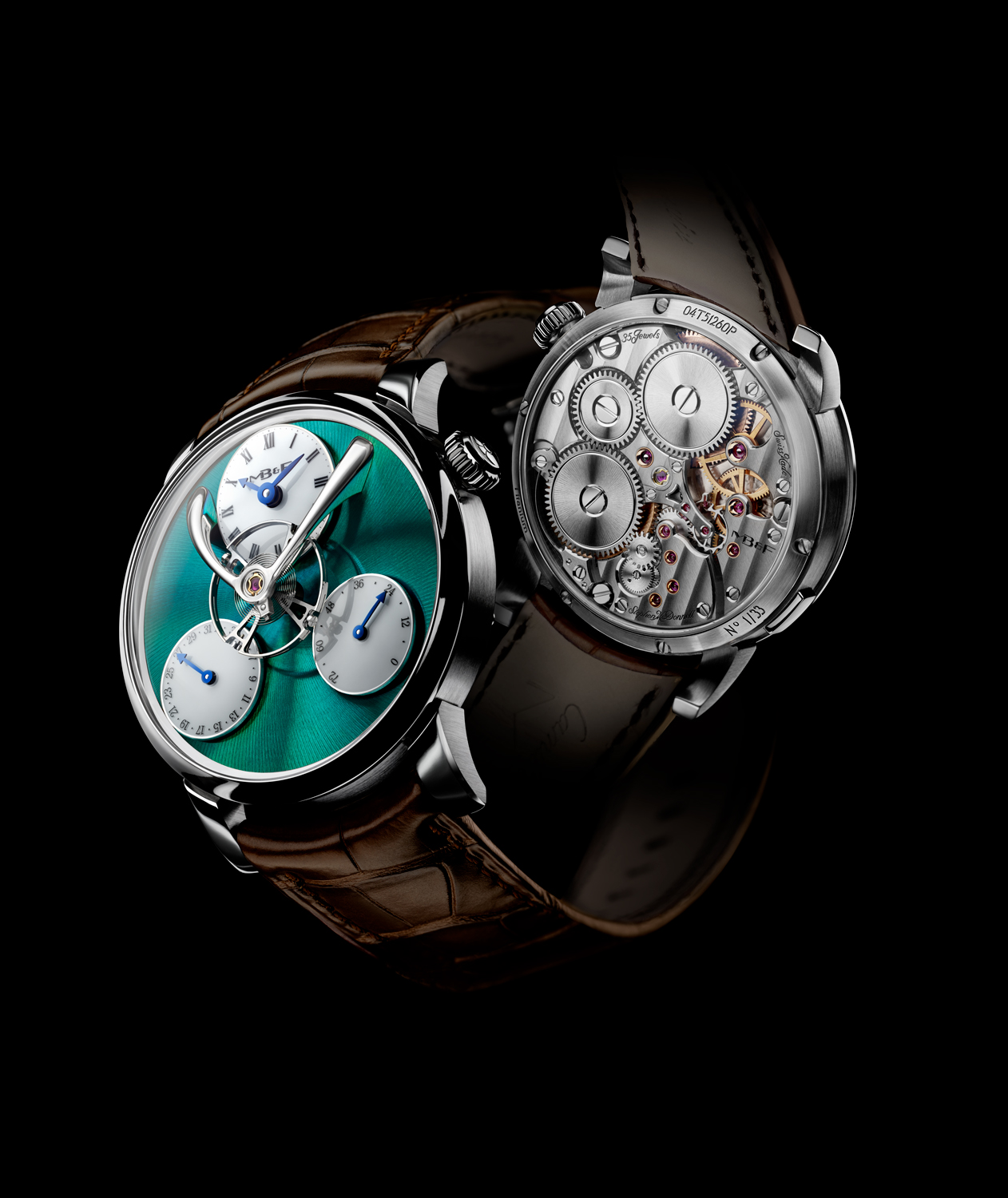
The first Legacy Machine drew on the atmosphere of wonder and optimism that characterised the World’s Fair expositions of the late 19th and early 20th centuries. The suspended balance was designed to channel this heady mix of emotions, an effect achieved by its sharp departure from established watchmaking tradition. By transporting the impulse jewel, anchor and escape wheel to the opposite end of the engine, Legacy Machine Split Escapement magnifies the visual impact of its balance, akin to an illusionist meticulously hiding all traces of the mechanisms that drive his latest show-stopping opus. And just like any other enigmatic feat of visual wonder, it’s achieved by bending some old rules and writing some new ones.
The sensitivity of the balance and the paramount role that it plays in chronometric precision are usually reason enough for watchmakers to avoid straying too far from convention when it comes to escapements. However, the outstanding horological mind of Stephen McDonnell, the watchmaker behind the award-winning Legacy Machine Perpetual, was able to circumvent the real and perceived hindrances to creating a new configuration of mechanical regulator.
Legacy Machine Perpetual was the first MB&F creation to utilise the split escapement in 2015, although the attention then was rightfully focused on the groundbreaking new perpetual calendar. Now, with Legacy Machine Split Escapement, the time for its eponymous feature has arrived.
Despite the technical hurdles faced in creating the split escapement, the LM SE engine is still designed with aesthetics and classicism in mind — beautifully symmetrical, with bridges that frame their underlying components and curve smoothly around gold chatons and countersunk jewels.
Dial-side, the balance bridge is the third iteration of a component that has been central in all Legacy Machines thus far. In the first Legacy Machines, the bridge was characterised by an industrialist aesthetic, but progressed to a more rounded form with a wedge-like base in Legacy Machine 101 and in the final edition of Legacy Machine N°1. In LM SE, similar to Legacy Machine Perpetual, the bridge assumes an organically arched line from end to end.
TECHNICAL CHALLENGES OF THE SPLIT ESCAPEMENT
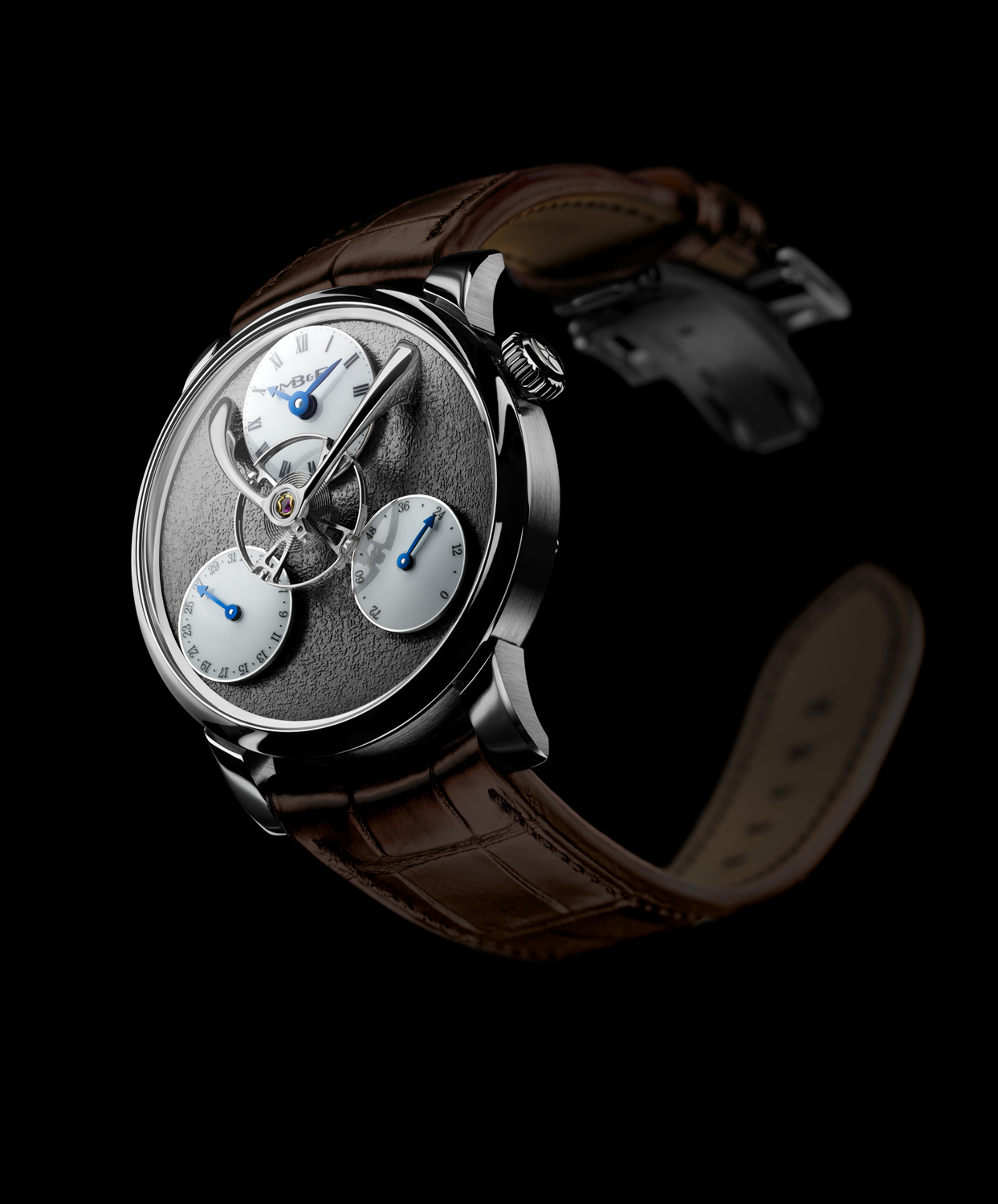
In watchmaking parlance, the escapement is the set of components that allows the stored energy of the mainspring to escape in a series of regular controlled impulses instead of unwinding all at once. In its most common configuration, it consists of the balance assembly, anchor and escape wheel, and horological tradition dictates that these components should be as close to each other as possible to minimise external disturbing influences. In this particular area of horology, which is rarely challenged, MB&F is doing a new thing.
Whilst the balance of LM Split Escapement beats just under the dial-side dome of sapphire crystal, its impulse jewel, anchor and escape wheel are on the other side of the movement, visible through the transparent caseback. This necessitates an unusually long balance arbour, which runs through the centre of the movement, a true milestone of micro-mechanical and manufacturing technique.
The distance between the balance wheel and the impulse jewel is a full 11.78 mm, the length of the arbour that traverses the movement and projects through the dial to support the oscillator. A longer arbour increases the likelihood of disrupting influences on the oscillator, as well as the potential distorting effects of a long axle under continuous torsion. The inertia of the balance and the rigidity of the arbour are key factors in this delicate equation, and the LM SE engine is precisely engineered to ensure its chronometric integrity.
In the Split Escapement, stability of construction becomes exponentially more important than it usually is, which significantly restricts the margin of dimensional error during the manufacturing process. In addressing this, the balance arbour is fitted at both ends with anti-shock jewel bearings, and the bridge that holds the anchor and escape wheel is separately fixed for optimal fine adjustment.
Because a longer balance arbour has a higher mass, which potentially detracts from the amount of energy ultimately transmitted to the oscillator, the LM SE engine is driven by two barrels in parallel, which allows up to 72 hours of optimal timekeeping.
FINE-FINISHING
The first launch editions featured very traditional finishing with a hand-frosted dial. The burnished surface finish is closely associated with watch movements from the 18th and 19th century. It was originally functional as well as decorative, providing an oxidised matte surface that resisted tarnish and gave off a subtle and even sheen, which is prized by antique collectors and enthusiasts.
Traditional methods of creating the frosted finish are no longer practicable, due to its hazardous nature (the procedure involved heating metal over an open flame before dipping it in concentrated nitric acid). To achieve the same effect, MB&F works with specialist craftsmen to recreate the texture and sheen of frosting without the use of chemicals.
The surface to be frosted is hand-worked with a wire brush, creating minute indentations one small area at a time. Each time, the wire brush must meet the metal surface with exactly the same angle and the same amount of pressure, and the indentations have to be evenly distributed over the entire surface in order to create the desired finish.
For Legacy Machine Split Escapement, a wider, more diffuse frosted finish was used, to accommodate the larger area and to draw attention to the hand-worked process. The surfaces were then PVD treated to colour them — blue, ruthenium, red gold or yellow gold.
The latest grade 5 titanium edition with green CVD-treated dial is decorated with a spectacular sun-ray finish, which catches the light from alternating angles and makes the dial colour vary between blue and green.
THE LEGACY MACHINE COLLECTION
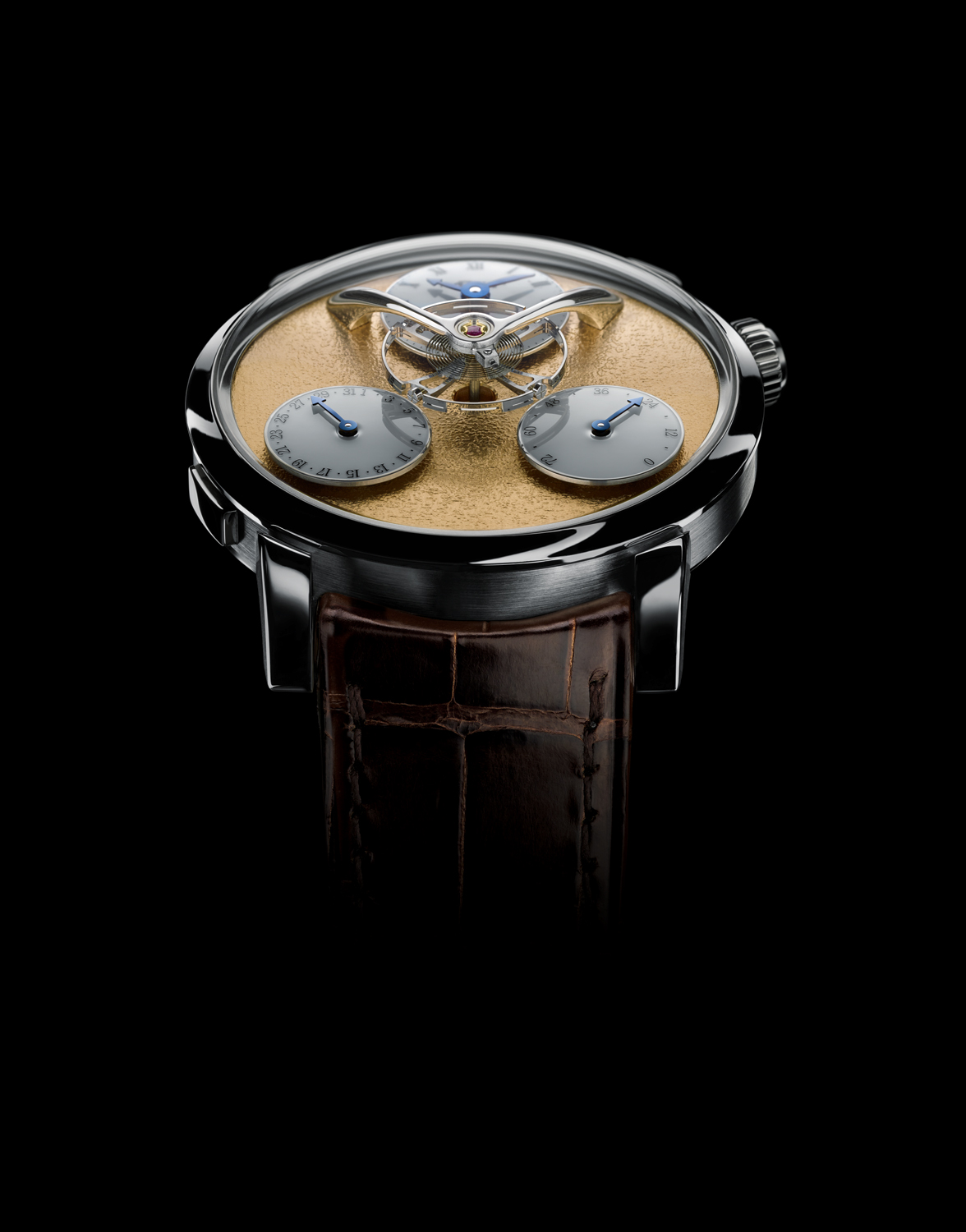
MB&F debuted the Legacy Machine collection in 2011, the result of a radical thought experiment by founder Maximilian Büsser: “What would have happened if I had been born in 1867 instead of 1967? In the early 1900s the first wristwatches appear and I would want to create three-dimensional machines for the wrist. There are no Grendizers, Star Wars or fighter jets for my inspiration, but I do have pocket watches, the Eiffel Tower and Jules Verne. So what might my early 20th-century machines look like? They had to be round (tradition) and three-dimensional (MB&F Machine): Legacy Machines are the answer.”
Legacy Machine N°1 simultaneously marked a sharp departure from the Horological Machines for which MB&F was already known, and also established the aesthetic codes for a new family of MB&F creations. Round cases, white lacquer dials, movements classically finished with Geneva stripes and polished chamfers, and the one disruptive element — the suspended balance — all the more arresting because of its wholly traditional setting.
Since the double time-display LM1 was released, the Legacy Machine collection has been completed with five further series, making six in total. Legacy Machine N°2, with its two regulators, premiered in 2013. Legacy Machine 101, the distillation of the aesthetics of the Legacy Machine collection and MB&F’s first in-house movement, came a year later, and the high-complication Legacy Machine Perpetual arrived in 2015. In 2019 MB&F released the LM FlyingT featuring a flying tourbillon, and the first MB&F Machine dedicated to women.
The emphasis on technical creativity that characterised LM Perpetual also defines LM Split Escapement, whose engine is derived from LM Perpetual but has shed its complication to reveal the innovation at its heart.
LM SPLIT ESCAPEMENT TECHNICAL SPECIFICATIONS
4 white gold launch editions limited to 18 pieces each, with a frosted dial plate in blue, ruthenium, red gold or yellow gold; and a limited edition of 33 pieces in titanium with a sun-ray-finish, green CVD dial.
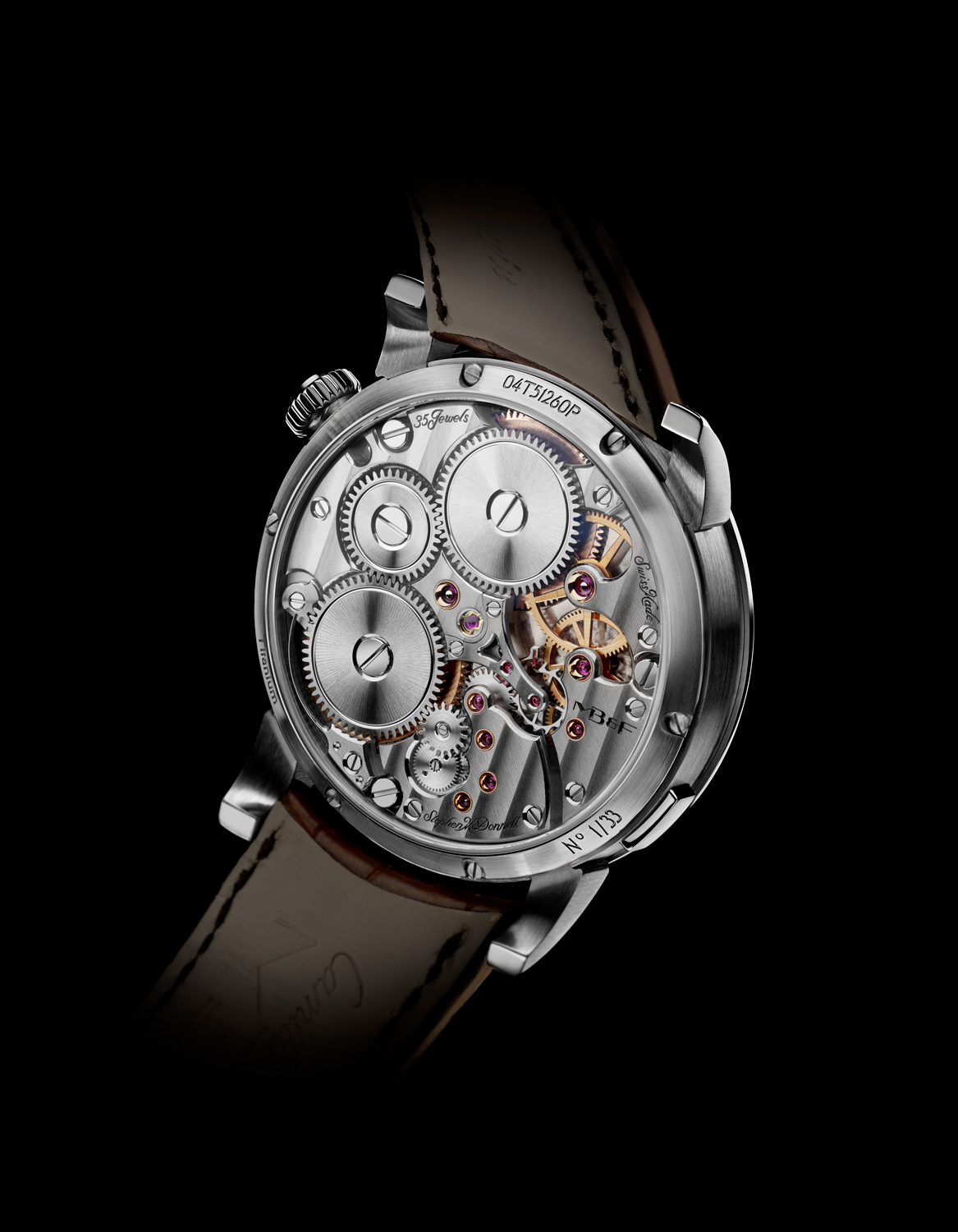
Engine
Movement developed for MB&F by Stephen McDonnell.
Split escapement with the balance wheel suspended above the dial and the anchor under the movement.
Manual winding with double mainspring barrels.
Bespoke 14mm balance wheel with traditional regulating screws visible on top of the movement.
Superlative hand finishing throughout respecting 19th-century style; bevelled internal angles highlighting hand craft; polished bevels; Geneva waves; hand-made frost and engravings.
Power reserve: 72 hours
Balance frequency: 2.5Hz / 18,000bph
Number of components: 314
Number of jewels: 35
Functions & indications
Hours, minutes, date and power-reserve indicators.
Push-button next to the date dial for quick adjustment of the date.
Case
Material: launch editions in 18K white gold; grade 5 titanium edition
Dimensions: 44mm x 17.5mm
Number of components: 49
Water resistance: 30m / 90′ / 3ATM
Sapphire crystals
Sapphire crystals on top and display back treated with anti-reflective coating on both faces.
Strap & buckle
Black or brown hand-stitched alligator strap with white-gold or titanium folding buckle matching the case.
‘FRIENDS’ RESPONSIBLE FOR LM SPLIT ESCAPEMENT
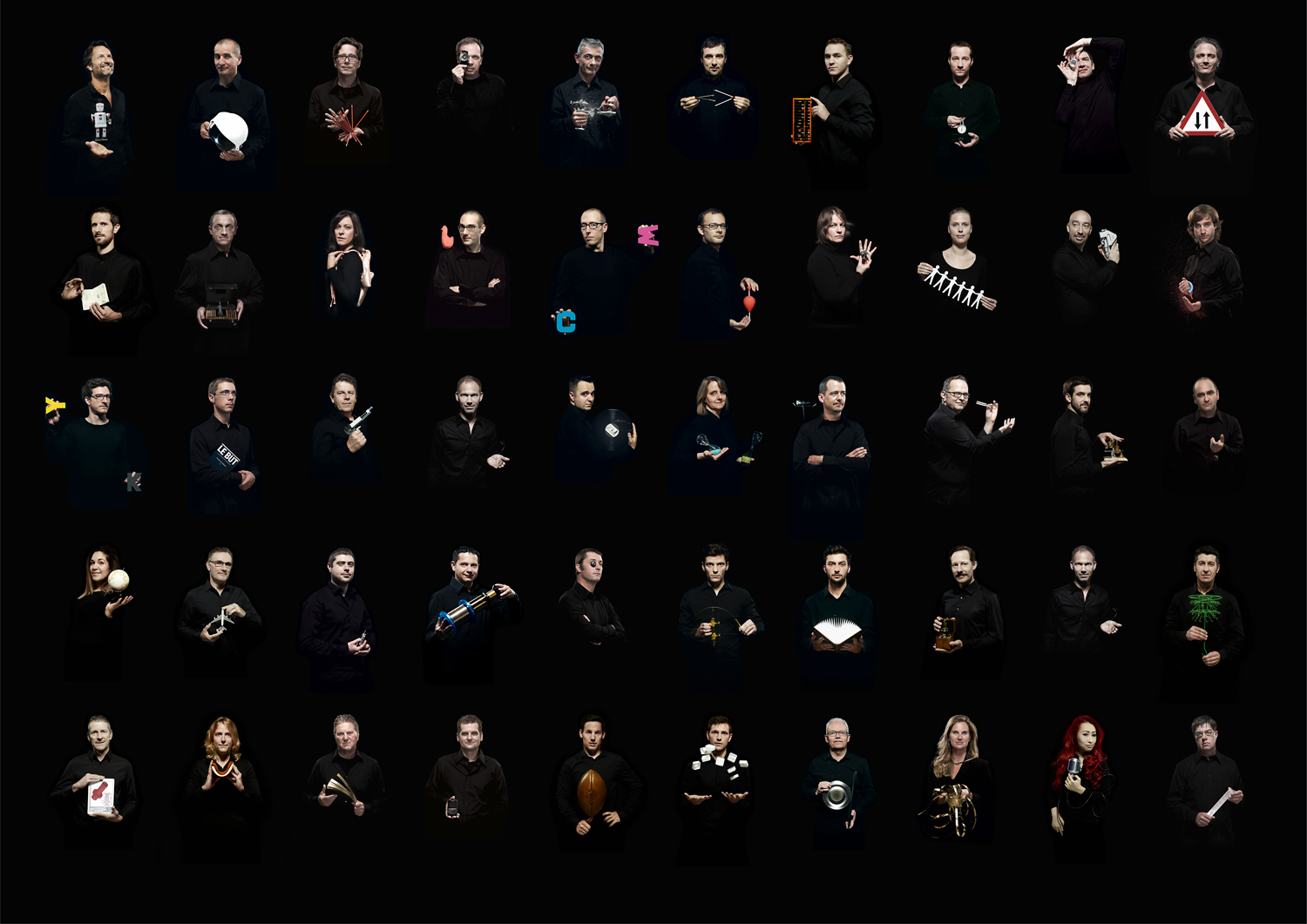
Concept: Maximilian Büsser / MB&F
Product design: Eric Giroud / Through the Looking Glass
Technical and production management: Serge Kriknoff / MB&F
Movement design and finish specifications: Stephen McDonnell and MB&F
Movement development: Stephen McDonnell and Ruben Martinez / MB&F
R&D: Ruben Martinez and Simon Brette / MB&F
Wheels, pinions and axis: Jean-François MOJON / Chronode, Paul-André Tendon / BANDI, AZUREA, Swiss Manufacturing and Le Temps Retrouvé.
Balance wheel bridge and plates: Benjamin Signoud / AMECAP
Balance wheel: Andreas Kurt / Precision Engineering
Balance spring: Stefan Schwab / Schwab-Feller
Case and bridges: Alain Lemarchand and Jean-Baptiste Prétot / MB&F
Fine-finishing of the case: Bripoli
Movement components: Alain Pellet / Elefil
Hand-finishing of movement components: Jacques-Adrien Rochat and Denis Garcia / C-L Rochat
PVD-treatment: Pierre-Albert Steinmann / Positive Coating
Movement assemblage: Didier Dumas, Georges Veisy, Anne Guiter, Emmanuel Maître, and Henri Porteboeuf / MB&F
After-sales service: Thomas Imberti / MB&F
Quality control: Cyril Fallet / MB&F
Dial: Hassan Chaïba and Virginie Duval / Les Ateliers d’Hermès Horloger
Buckle: Dominique Mainier / G&F Châtelain
Crown: Cheval Frères
Hands: Pierre Chillier and Isabelle Chillier / Fiedler
Sapphire crystals: Martin Stettler / Stettler
Strap: Kim Amanton / Multicuirs
Presentation box: ATS Atelier Luxe
Production logistics: David Lamy, Isabel Ortega and Raphaël Buisine / MB&F
Marketing & Communication: Charris Yadigaroglou, Virginie Toral, Juliette Duru, Arnaud Légeret and Maëna Le Gat / MB&F
Sales: Thibault Verdonckt, Stéphanie Réa, Anna Rouveure and Jean-Marc Bories / MB&F
Design graphique: Samuel Pasquier / MB&F, Adrien Schulz and Gilles Bondallaz / Z+Z
Photographies du produit: Maarten van der Ende and Alex Teuscher / Alex Stephen Teuscher photography
Portrait Photographies: Régis Golay / Federal
Webmasters: Stéphane Balet / Nord Magnétique, Victor Rodriguez and Mathias Muntz / Nimeo
Film: Marc-André Deschoux / MAD LUX
Textes: Suzanne Wong / REVOLUTION Switzerland
MB&F – Genesis of a Concept Laboratory
2019 marked the 14th year of hyper-creativity for MB&F, the world’s first-ever horological concept laboratory. With 15 remarkable calibres forming the base of the critically acclaimed Horological and Legacy Machines, MB&F is continuing to follow Founder and Creative Director Maximilian Büsser’s vision of creating 3-D kinetic art by deconstructing traditional watchmaking.
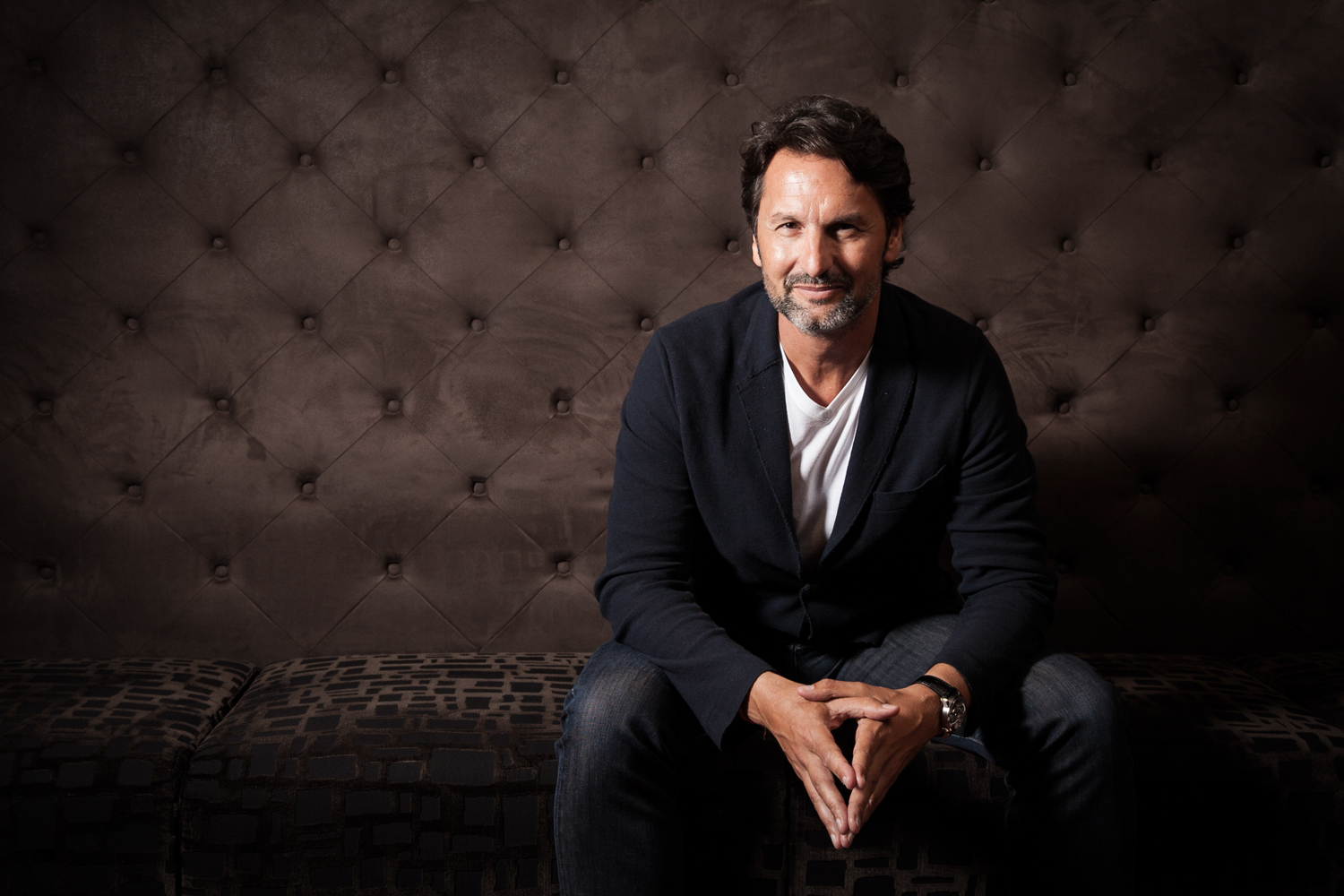
After 15 years managing prestigious watch brands, Maximilian Büsser resigned from his Managing Director position at Harry Winston in 2005 to create MB&F – Maximilian Büsser & Friends. MB&F is an artistic and micro-engineering laboratory dedicated to designing and crafting small series of radical concept watches by bringing together talented horological professionals that Büsser both respects and enjoys working with.
In 2007, MB&F unveiled its first Horological Machine, HM1. HM1’s sculptured, three-dimensional case and beautifully finished engine (movement) set the standard for the idiosyncratic Horological Machines that have followed – all Machines that tell the time, rather than Machines to tell the time. The Horological Machines have explored space (HM2, HM3, HM6), the sky (HM4, HM9), the road (HM5, HMX, HM8) and water (HM7).
In 2011, MB&F launched its round-cased Legacy Machine collection. These more classical pieces – classical for MB&F, that is – pay tribute to nineteenth-century watchmaking excellence by reinterpreting complications from the great horological innovators of yesteryear to create contemporary objets d’art. LM1 and LM2 were followed by LM101, the first MB&F Machine to feature a movement developed entirely in-house. LM Perpetual and LM Split Escapement broadened the collection further. 2019 marks a turning point with the creation of the first MB&F Machine dedicated to women: LM FlyingT. MB&F generally alternates between launching contemporary, resolutely unconventional Horological Machines and historically inspired Legacy Machines.
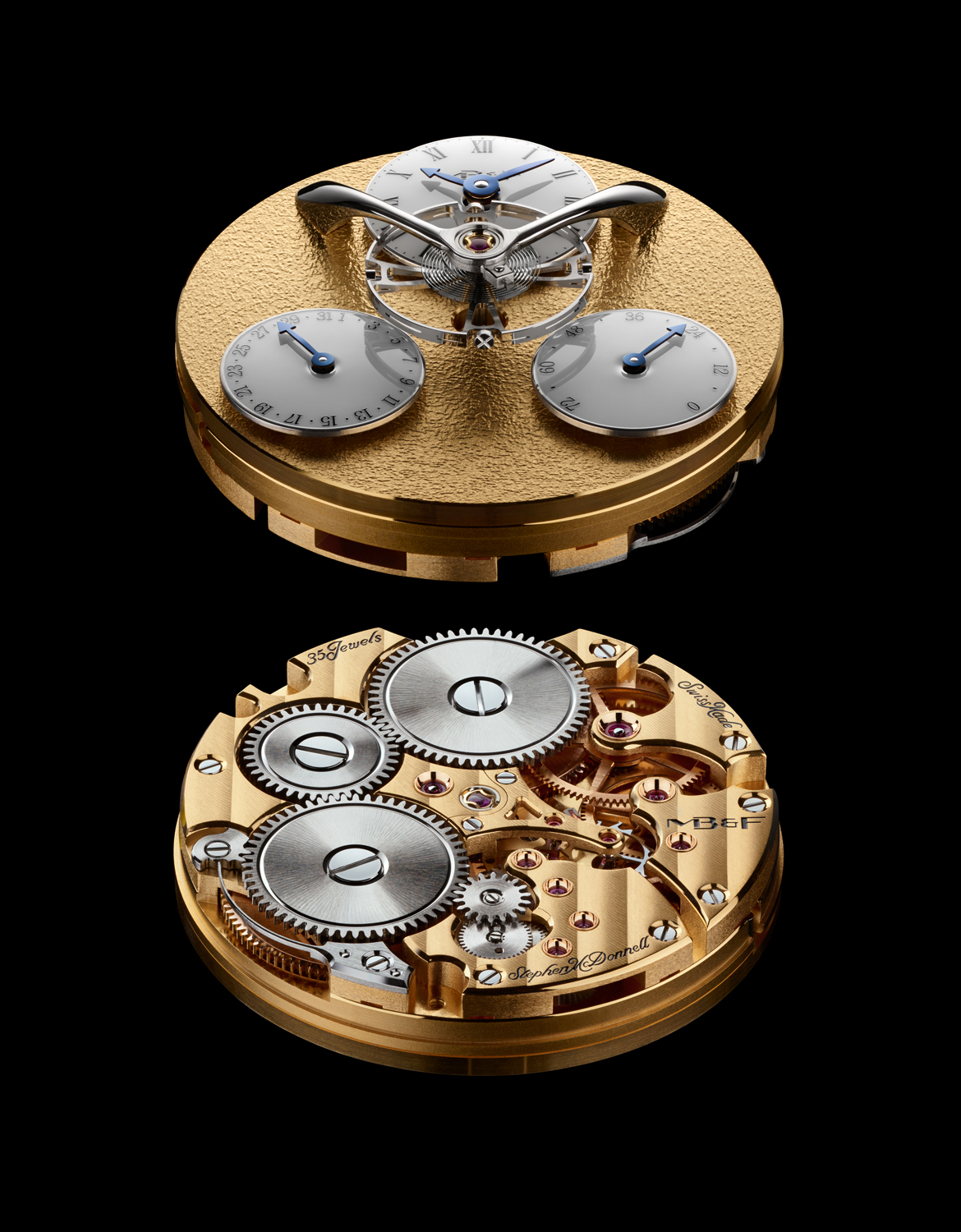
As the F stands for Friends, it was only natural for MB&F to develop collaborations with artists, watchmakers, designers and manufacturers they admire.
This brought about two new categories: Performance Art and Co-creations. While Performance Art pieces are MB&F machines revisited by external creative talent, Co-creations are not wristwatches but other types of machines, engineered and crafted by unique Swiss Manufactures from MB&F ideas and designs. Many of these Co-creations, such as the clocks created with L’Epée 1839, tell the time while collaborations with Reuge and Caran d’Ache generated other forms of mechanical art.
To give all these machines an appropriate platform, Büsser had the idea of placing them in an art gallery alongside various forms of mechanical art created by other artists, rather than in a traditional storefront. This brought about the creation of the first MB&F M.A.D.Gallery (M.A.D. stands for Mechanical Art Devices) in Geneva, which would later be followed by M.A.D.Galleries in Taipei, Dubai and Hong Kong.
There have been distinguished accolades reminding us of the innovative nature of MB&F’s journey so far. To name a few, there have been no less than 4 Grand Prix awards from the famous Grand Prix d’Horlogerie de Genève: in 2016, LM Perpetual won the Grand Prix for Best Calendar Watch; in 2012, Legacy Machine No.1 was awarded both the Public Prize (voted for by horology fans) and the Best Men’s Watch Prize (voted for by the professional jury). In 2010, MB&F won Best Concept and Design Watch for the HM4 Thunderbolt. In 2015 MB&F received a Red Dot: Best of the Best award – the top prize at the international Red Dot Awards – for the HM6 Space Pirate.

